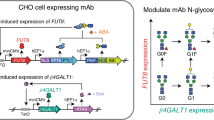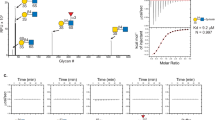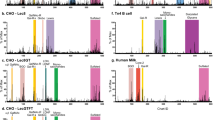Abstract
N-glycosylation is critical to the function of monoclonal antibodies (mAbs) and distinguishes various systems used for their production. We expressed human mAbs in the small aquatic plant Lemna minor, which offers several advantages for manufacturing therapeutic proteins free of zoonotic pathogens1. Glycosylation of a mAb against human CD30 was optimized by co-expressing the heavy and light chains of the mAb with an RNA interference construct targeting expression of the endogenous α-1,3-fucosyltransferase and β-1,2-xylosyltransferase genes. The resultant mAbs contained a single major N-glycan species without detectable plant-specific N-glycans and had better antibody-dependent cell-mediated cytotoxicity and effector cell receptor binding activities than mAbs expressed in cultured Chinese hamster ovary (CHO) cells.
This is a preview of subscription content, access via your institution
Access options
Subscribe to this journal
Receive 12 print issues and online access
$209.00 per year
only $17.42 per issue
Buy this article
- Purchase on Springer Link
- Instant access to full article PDF
Prices may be subject to local taxes which are calculated during checkout



Similar content being viewed by others
References
Gasdaska, J., Spencer, D. & Dickey, L. Advantages of therapeutic protein production in the aquatic plant Lemna. Bioprocessing J. 3, 50–56 (2003).
Krapp, S., Mimura, Y., Jefferis, R., Huber, R. & Sondermann, P. Structural analysis of human IgG-Fc glycoforms reveals a correlation between glycosylation and structural integrity. J. Mol. Biol. 325, 979–989 (2003).
Shinkawa, T. et al. The absence of fucose but not the presence of galactose or bisecting N-acetylglucosamine of human IgG1 complex-type oligosaccharides shows the critical role of enhancing antibody-dependent cellular cytotoxicity. J. Biol. Chem. 278, 3466–3473 (2003).
Shields, R.L. et al. Lack of fucose on human IgG1 N-linked oligosaccharide improves binding to human FcγRIII and antibody-dependent cellular toxicity. J. Biol. Chem. 277, 26733–26740 (2002).
Wright, A. & Morrison, S. Effect of glycosylation on antibody function: Implications for genetic engineering. Trends Biotechnol. 15, 26–32 (1997).
Hiatt, A., Cafferkey, R. & Bowdish, K. Production of antibodies in transgenic plants. Nature 342, 76–78 (1989).
Bakker, H. et al. An antibody produced in tobacco expressing a hybrid β-1,4-galactosyltransferase is essentially devoid of plant carbohydrate epitopes. Proc. Natl. Acad. Sci. USA 103, 7577–7582 (2006).
Triguero, A. et al. Plant-derived mouse IgG monoclonal antibody fused to KDEL endoplasmic reticulum-retention signal is N-glycosylated homogeneously throughout the plant with mostly high-mannose-type N-glycans. Plant Biotechnol. J. 3, 449–457 (2005).
Bardor, M. et al. Monoclonal C5-1 antibody produced in transgenic alfalfa plants exhibits a N-glycosylation that is homogenous and suitable for glyco-engineering into human-compatible structures. Plant Biotechnol. J. 1, 451–462 (2003).
Gomord, V., Chamberlain, P., Jefferis, R. & Faye, L. Biopharmaceutical production in plants: Problems, solutions and opportunities. Trends Biotechnol. 23, 559–565 (2005).
Zeitlin, L. et al. A humanized monoclonal antibody produced in transgenic plants for immunoprotection of the vagina against genital herpes. Nat. Biotechnol. 16, 1361–1364 (1998).
Ma, J.K. et al. Characterization of a recombinant plant monoclonal secretory antibody and preventative immunotherapy in humans. Nat. Med. 4, 601–606 (1998).
Bencurova, M., Hemmer, W., Focke-Tejkl, M., Wilson, I. & Altmann, F. Specificity of IgG and IgE antibodies against plant and insect glycoprotein glycans determined with artificial glycoforms of human transferrin. Glycobiology 14, 457–466 (2004).
Yamamoto, Y. et al. Genetic transformation of duckweed Lemna gibba and Lemna minor. In Vitro Cell. Dev. Biol. 37, 349–353 (2001).
Borchmann, P. et al. The human anti-CD30 antibody 5F11 shows in vitro and in vivo activity against malignant lymphoma. Blood 102, 3737–3742 (2003).
Zhu, L. et al. Production of human monoclonal antibody in eggs of chimeric chickens. Nat. Biotechnol. 23, 1159–1169 (2005).
Elbers, I.J. et al. Influence of growth conditions and developmental stage on N-glycan heterogeneity of transgenic immunoglobulin G and endogenous proteins in tobacco leaves. Plant Physiol. 126, 1314–1322 (2001).
Fujiyama, K. et al. N-linked glycan structures of a mouse monoclonal antibody produced from tobacco BY2 suspension-cultured cells. J. Biosci. Bioeng. 101, 212–218 (2006).
Koprivova, A. et al. N-glycosylation in the moss Physcomitrella patens is organized similarly to that in higher plants. Plant Biol. 5, 582–591 (2003).
Kanda, Y. et al. Comparison of cell lines for stable production of fucose-negative antibodies with enhanced ADCC. Biotechnol. Bioeng. 94, 680–688 (2006).
Cartron, G. et al. Therapeutic activity of humanized anti-CD20 monoclonal antibody and polymorphism in IgG Fc receptor FcγRIIIa gene. Blood 99, 754–758 (2002).
Weng, W.K. & Levy, R. Two immunoglobulin G fragment C receptor polymorphisms independently predict response to rituximab in patients with follicular lymphoma. J. Clin. Oncol. 21, 3940–3947 (2003).
Weng, W.K., Czerwinski, D., Timmerman, J., Hsu, F. & Levy, R. Clinical outcome of lymphoma patients after idiotype vaccination is correlated with humoral immune response and immunoglobulin G Fc receptor genotype. J. Clin. Oncol. 22, 4717–4724 (2004).
Niwa, R. et al. Enhancement of the antibody-dependent cellular cytotoxicity of low-fucose IgG1 is independent of FcγRIIIa functional polymorphism. Clin. Cancer Res. 10, 6248–6255 (2004).
Urlaub, G. et al. Effect of gamma rays at the dihydrofolate reductase locus: deletions and inversions. Somat. Cell Mol. Genet. 12, 555–566 (1986).
Hepburn, A.G. et al. The use of pNJ5000 as an intermediate vector for the genetic manipulation of Agrobacterium Ti-plasmids. J. Gen. Microbiol. 131, 2961–2969 (1985).
Schenk, R. & Hildenbrandt, A. Medium and techniques for induction and growth of monocotyledonous and dictoyledonous plant cell cultures. Can. J. Bot. 50, 199–204 (1972).
Leiter, H. et al. Purification, cDNA cloning, and expression of GDP-L-Fuc:Asn-linked GlcNAc α-1,3-fucosyltransferase from mung beans. J. Biol. Chem. 274, 21830–21839 (1999).
Packer, N., Lawson, M., Jardine, D. & Redmond, J. A general approach to desalting oligosaccharides released from glycoproteins. Glycoconj. J. 49, 737–747 (1998).
Anumula, K.R. & Dhume, S. High resolution and high sensitivity methods for oligosaccharide mapping and characterization by normal phase high performance liquid chromatography following derivatization with highly fluorescent anthranilic acid. Glycobiology 8, 685–694 (1998).
Acknowledgements
We wish to acknowledge Rachel Loranger, Betsy Adams, Heather Hilton, Vincent Wingate, Nirmala Rajbhandari, Lee Shirkey and Nancy Whitt for their work on the MDX-060 project and Ming-Bo Wang for his help in construct design.
Author information
Authors and Affiliations
Corresponding author
Ethics declarations
Competing interests
The authors declare no competing financial interests.
Supplementary information
Supplementary Table 1
Comparison of the thermal stabilities of MDX-060 CHO, MDX-060 LEX and glyco-optimized MDX-060 LEXOpt mAbs by differential scanning calorimetry (DSC) (DOC 24 kb)
Supplementary Table 2
Monosaccharides released from MDX-060 CHO, LEX and LEXOpt mAbs by acid hydrolysis and analyzed by HPAEC-PAD (DOC 26 kb)
Rights and permissions
About this article
Cite this article
Cox, K., Sterling, J., Regan, J. et al. Glycan optimization of a human monoclonal antibody in the aquatic plant Lemna minor. Nat Biotechnol 24, 1591–1597 (2006). https://doi.org/10.1038/nbt1260
Received:
Accepted:
Published:
Issue Date:
DOI: https://doi.org/10.1038/nbt1260
This article is cited by
-
Mechanism of cooperative N-glycan processing by the multi-modular endoglycosidase EndoE
Nature Communications (2022)
-
N-glycosylation, a leading role in viral infection and immunity development
Molecular Biology Reports (2022)
-
Plant-derived VLP: a worthy platform to produce vaccine against SARS-CoV-2
Biotechnology Letters (2022)



